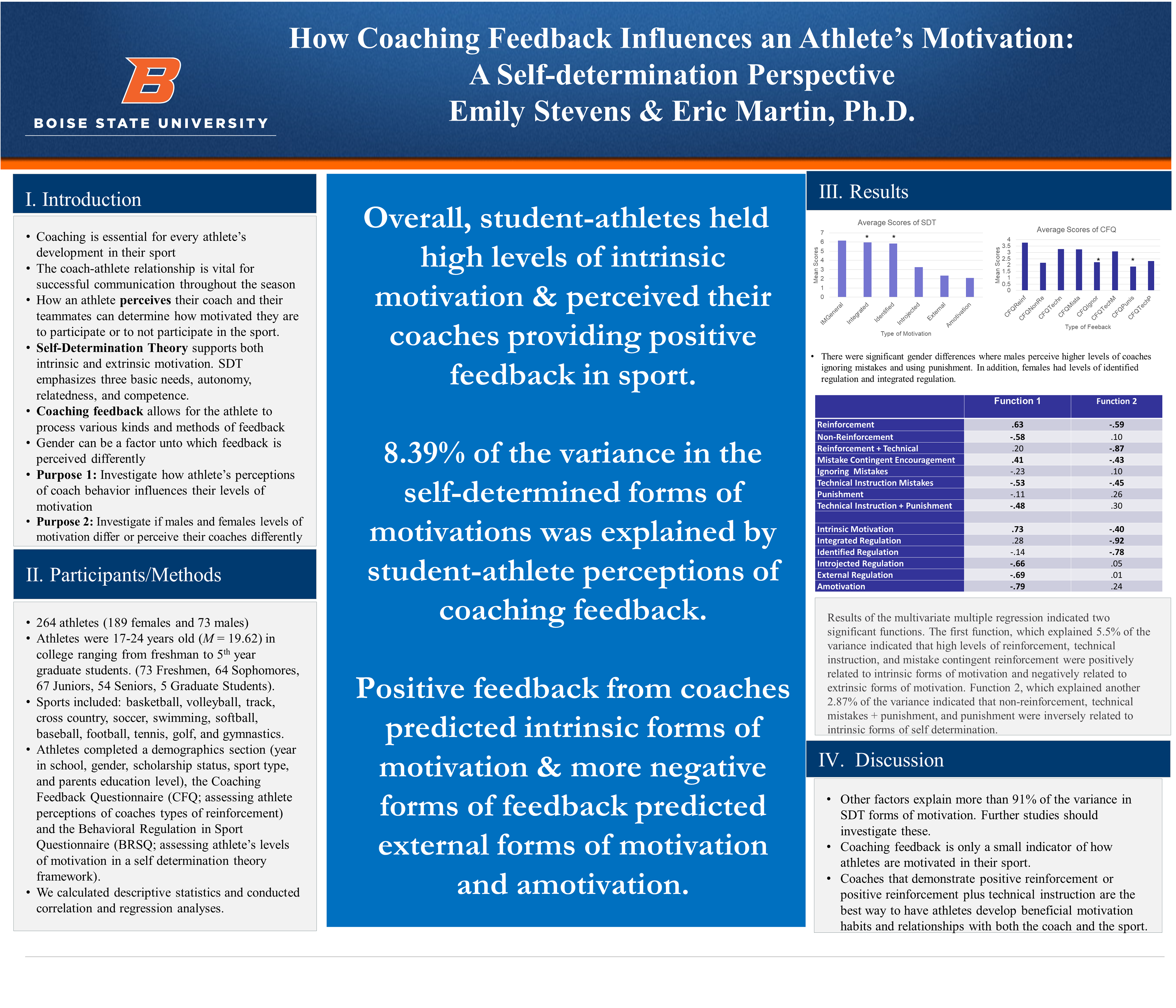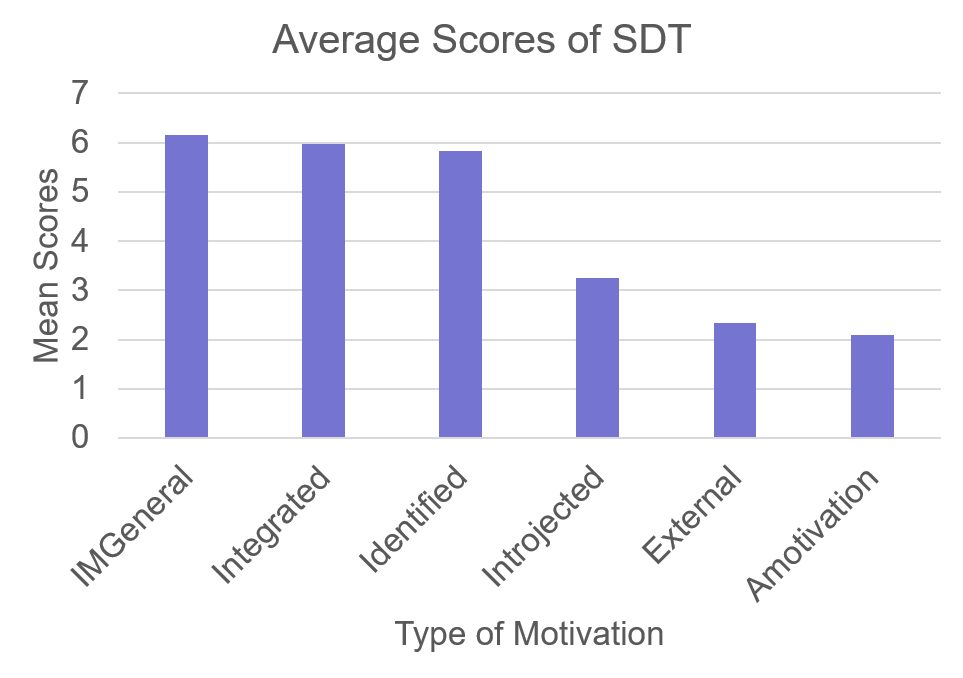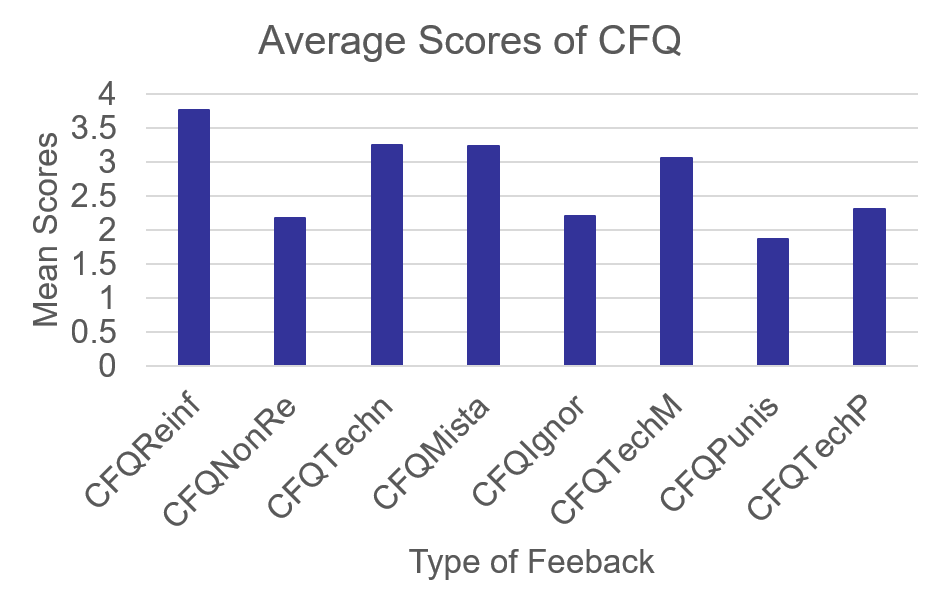Emily Stevens, Dr. Eric Martin

Introduction
- Coaching is essential for every athlete’s development in their sport
- The coach-athlete relationship is vital for successful communication throughout the season
- How an athlete perceivestheir coach and their teammates can determine how motivated they are to participate or to not participate in the sport.
- Self-Determination Theory supports both intrinsic and extrinsic motivation. SDT emphasizes three basic needs, autonomy, relatedness, and competence.
- Coaching feedback allows for the athlete to process various kinds and methods of feedback
- Gender can be a factor unto which feedback is perceived differently
- Purpose 1: Investigate how athlete’s perceptions of coach behavior influences their levels of motivation
- Purpose 2:Investigate if males and females levels of motivation differ or perceive their coaches differently
Participants/Methods
- 264 athletes (189 females and 73 males)
- Athletes were 17-24 years old (M= 19.62) in college ranging from freshman to 5thyear graduate students. (73 Freshmen, 64 Sophomores, 67 Juniors, 54 Seniors, 5 Graduate Students).
- Sports included: basketball, volleyball, track, cross country, soccer, swimming, softball, baseball, football, tennis, golf, and gymnastics.
- Athletes completed a demographics section (year in school, gender, scholarship status, sport type, and parents education level), the Coaching Feedback Questionnaire (CFQ; assessing athlete perceptions of coaches types of reinforcement) and the Behavioral Regulation in Sport Questionnaire (BRSQ; assessing athlete’s levels of motivation in a self determination theory framework).
- We calculated descriptive statistics and conducted correlation and regression analyses.
Overall, student-athletes held high levels of intrinsic motivation & perceived their coaches providing positive feedback in sport.
8.39% of the variance in the self-determined forms of motivations was explained by student-athlete perceptions of coaching feedback.
Positive feedback from coaches predicted intrinsic forms of motivation & more negative forms of feedback predicted external forms of motivation and motivation.
Results


There were significant gender differences where males perceive higher levels of coaches ignoring mistakes and using punishment. In addition, females had levels of identified regulation and integrated regulation.
| Category | Function 1 | Function 2 |
|---|---|---|
| Reinforcement | .63 | -.59 |
| Non-reinforcement | -.58 | .10 |
| Reinforcement + Technical | .20 | -.87 |
| Mistake Contingent Encouragement | .41 | -.43 |
| Ignoring Mistakes | -.23 | .10 |
| Technical Instruction Mistakes | -.53 | -.45 |
| Punishment | -.11 | .26 |
| Technical Instruction + Punishment | -.48 | .30 |
| Intrinsic Motivation | .73 | .40 |
| Integrated Regulation | .28 | -.92 |
| Identified Regulation | -.14 | -.78 |
| Introjected Regulation | -.66 | .05 |
| External Regulation | -.69 | .01 |
| Amotivation | -.79 | .24 |
Results of the multivariate multiple regression indicated two significant functions. The first function, which explained 5.5% of the variance indicated that high levels of reinforcement, technical instruction, and mistake contingent reinforcement were positively related to intrinsic forms of motivation and negatively related to extrinsic forms of motivation. Function 2, which explained another 2.87% of the variance indicated that non-reinforcement, technical mistakes + punishment, and punishment were inversely related to intrinsic forms of self determination.
Discussion
Other factors explain more than 91% of the variance in SDT forms of motivation. Further studies should investigate these.
Coaching feedback is only a small indicator of how athletes are motivated in their sport.
Coaches that demonstrate positive reinforcement or positive reinforcement plus technical instruction are the best way to have athletes develop beneficial motivation habits and relationships with both the coach and the sport.
Additional Information
For questions or comments about this research, contact Emily Stevens at emilystevens@u.boisestate.edu.